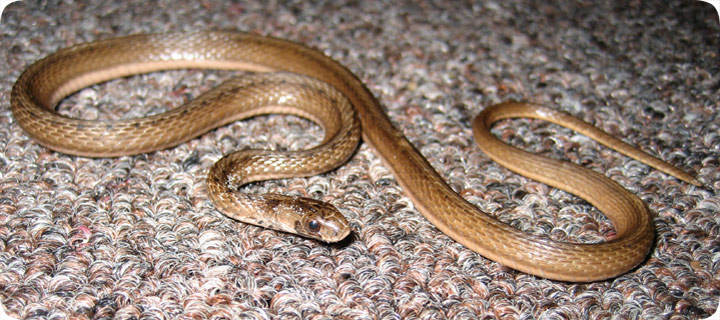-
info@aaanimalcontrol.com
Call us for help in your town
Humane Wildlife Education
Florida Brown Snake

12.06.2006 - The Florida Brown Snake Storeria victais is tiny, and it rarely grows to longer than a foot in length. It ranges throughout most of the Florida peninsula. It's not a very common snake, and because of its small size, boring brown color, and reclusive
nature, it's not commonly seen. It's a member of the common colubrid family of snakes, it's active during the daytime, it mostly eats bugs and little amphibians and reptiles such as anoles, and it give birth to live young in the summer. It's not venomous.
I caught this lovely specimen in one of my snake traps, while on a job to try to remove some more dangerous Pygmy Rattlesnakes. I check the snake traps every day, and lo and behold, I'd caught this harmless little guy. The snake trap uses a glue pad that the snake gets
stuck on. I poured some vegetable oil on it, and it squirmed around for a minute or two, and then it came loose. I got some warm water and rinsed the snake off, let it dry, and then took some photos of this nice and docile specimen. I then released it. Simple enough,
that's the tremendously exciting tale of the capture of the tremendously exciting Florida Brown Snake. You have just read part of a day in the tremendously exciting life of David the nuisance wildlife trapper.
Do it yourself: Visit my How To Get Rid of Snakes page for tips and advice.
Get professional help: Visit my Nationwide Pro Directory of wildlife removal experts.
For more wildlife stories, click my Wildlife Blog
or click my below banner to hire a local trapper.
You can also catch snakes with a special trap, which you can order by clicking this banner:

Another one of the well-known snake species in Florida is the brown snake. They are known to be natives to the southeast of the United States, located mostly in Florida along with other locations such as Georgia and other southern coastal states.
Like the black racer, this is a specie that does not produce any venom and therefore will not be able to poison their predators when bitten.
Appearance
The Florida brown snake is considered to be one of the smallest kind of its specie. They reach an average of about 12 inches long. Although, they could be as little as 10 centimeters to about half a meter in length. They are also rather thin, being only a few centimeters across. However, their heads are often slightly wider than the rest of their bodies.
The brown snake comes in the colors brown, yellow, red, gray, and sometimes even slightly silver. They will commonly have a brown back and whitish belly with a few dark spots. Their belly tends to be lighter in color than the rest of their body.
A distinct feature in the brown snake's pattern, however, is the banded pattern on their neck. It is usually a light color but can be a darker one or somewhat red. Another is the spot they have under each eye. This also comes in a range of colors, although it is usually dark.
Diet
A brown snake's primary diet consists of earthworms, snails, frogs, small fish, and salamanders. Although, they are quite the hunters and will have any prey they can take down for their meal. At certain times, they will also eat small birds and other snakes.
Since this type of specie does not produce any venom, which means they cannot poison their prey, they make use of brute force and jaw strength to overpower their catches.
Behavior
Brown snakes are the type to prefer burrowing instead of simply slithering on land. They are also nocturnal, which means they do most of their activities during the night time rather than during the day.
With people, they can be rather non-aggressive and would rather hide from them rather than try to put up a fight. Regardless, even if they were to attack any potential threats, there would only be a risk of infection since the snake's bite isn't poisonous.
Habitat
The brown snake inhabits almost the entire state of Florida and is scattered about in the nearby states and areas. Most of the time, they are spotted among leaf litter and other plant debris. Sometimes they will even be under rocks, dead trees, and possibly even in yards and gardens every now and then.
Despite enjoying these parts of the land, they actually prefer to live near water. Because of this, they are mostly found in parts of Florida where there are swamps, marshes, ponds, lakes, etc. Occasionally, though, they are seen in open grassy fields and other forested areas. But this is something that would most likely only appear when the brown snake is on their way to migrate to a new habitat.




















